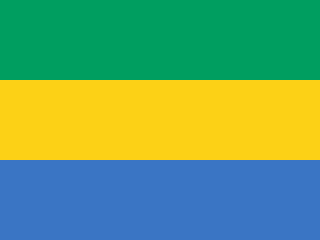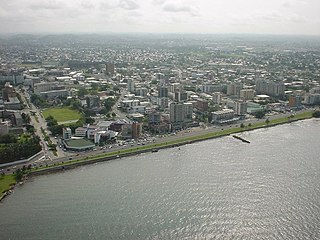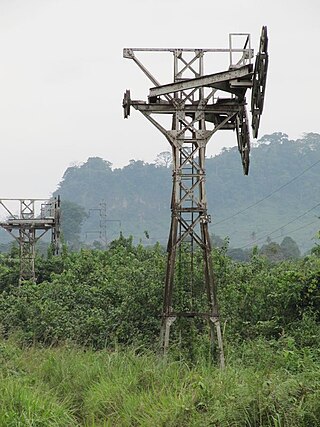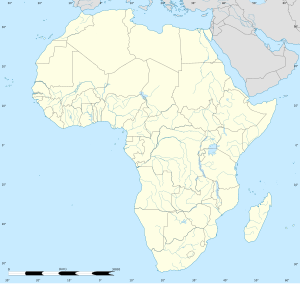
Gabon, officially the Gabonese Republic, is a country on the west coast of Central Africa. Located on the equator, it is bordered by Equatorial Guinea to the northwest, Cameroon to the north, the Republic of the Congo on the east and south, and the Gulf of Guinea to the west. It has an area of nearly 270,000 square kilometres (100,000 sq mi) and its population is estimated at 2.3 million people. There are coastal plains, mountains, and a savanna in the east.
Little is known of the history of Gabon prior to European contact. Bantu migrants settled the area beginning in the 14th century. Portuguese explorers and traders arrived in the area in the late 15th century. The coast subsequently became a center of the transatlantic slave trade with European slave traders arriving to the region in the 16th century. In 1839 and 1841, France established a protectorate over the coast. In 1849, captives released from a captured slave ship founded Libreville. In 1862–1887, France expanded its control including the interior of the state, and took full sovereignty. In 1910 Gabon became part of French Equatorial Africa and in 1960, Gabon became independent.

Libreville is the capital and largest city of Gabon. Occupying 65 square kilometres (25 sq mi) in the northwestern province of Estuaire, Libreville is a port on the Komo River, near the Gulf of Guinea. As of the 2013 census, its population was 703,904.

Oklo is a region near the town of Franceville, in the Haut-Ogooué province of the Central African country of Gabon. Several natural nuclear fission reactors were discovered in the uranium mines in the region in 1972.

The Ogooué, also known as the Nazareth river, some 1,200 kilometres (750 mi) long, is the principal river of Gabon in west central Africa and the fifth largest river in Africa by volume of discharge, trailing only the Congo, Kasai, Niger and Zambezi. Its watershed drains nearly the entire country of Gabon, with some tributaries reaching into the Republic of the Congo, Cameroon, and Equatorial Guinea.

A natural nuclear fission reactor is a uranium deposit where self-sustaining nuclear chain reactions occur. The conditions under which a natural nuclear reactor could exist had been predicted in 1956 by Paul Kuroda. The remnants of an extinct or fossil nuclear fission reactor, where self-sustaining nuclear reactions have occurred in the past, can be verified by analysis of isotope ratios of uranium and of the fission products. An example of this phenomenon was discovered in 1972 in Oklo, Gabon by Francis Perrin under conditions very similar to Kuroda's predictions.
Articles related to Gabon include:

Port-Gentil or Mandji is the second-largest city of Gabon, and it is a leading seaport. It is the center of Gabon's petroleum and timber industries. The city is located on a delta island in the Ogooue delta with no bridges to the mainland. Nearby Cape Lopez is Gabon's westernmost point. As of 2013 census, it had a population of 136,462.

Moanda is one of the largest towns in Gabon, lying on the N3 road in Haut Ogooué. It is also one of the most important manganese mining towns in the world, under the auspices of the Compagnie Minière de l'Ogooué (COMILOG), which began mining in 1957. Moanda has a population of around 39,298 inhabitants and is the second largest city in the Haut Ogooué Region, after Franceville. It is also a border town, lying 100 km away from the border with the Republic of Congo.

Education in Gabon is largely based on the French educational system. On the federal level, it is regulated by two Ministries: the Ministry of Education, which is in charge of Pre-school through to High School, and the Ministry of Higher Education and Innovative Technologies, which is in charge of universities and professional schools.

Mpassa is a department of Haut-Ogooué Province in south-eastern Gabon. The capital is Franceville. It had a population of 129,694 in 2013.
Uranium production is an important part of the African economy, with Niger, Namibia and South Africa creating up to 18% of the world's annual production. Many African countries produce uranium or have untapped uranium ore deposits.
Richard Auguste Onouviet is a Gabonese politician who has been President of the National Assembly of Gabon since 2016. Holding a succession of ministerial portfolios, Onouviet served in the government of Gabon as Minister of Water and the Environment from 1999 to 2002, Minister of Mines, Energy, and Oil from 2002 to 2007, Minister of Planning from 2007 to 2009, and as Minister of Decentralization and Urban Policy in 2009. A member of the Gabonese Democratic Party (PDG), he has been a Deputy in the National Assembly since 2009.

Solange Mabignath is a Gabonese politician and administrator.

The Compagnie minière de l'Ogooué, or COMILOG, is a manganese mining and processing company based in Moanda, Gabon. It is a subsidiary of the French metallurgical group Eramet. The company is the world's second largest producer of manganese ore. At first the ore was carried by a cableway to the border with the Republic of the Congo, then by rail to the sea at Pointe-Noire. In the 1980s a railway was built to carry the ore through Gabon to the sea near Libreville.
Gabon is situated at the northwestern margin of the Congo Craton—a region of stable, ancient crust—and preserves very ancient rock units across 75% of the country, with overlying sedimentary units from the Cretaceous and other more recent periods.

Oklo Mine, located in Oklo, Gabon on the west coast of Central Africa, is believed to be the only natural nuclear fission reactor. Oklo consists of 16 sites at which self-sustaining nuclear fission reactions are thought to have taken place approximately 1.7 billion years ago, and ran for hundreds of thousands of years. It is estimated to have averaged under 100 kW of thermal power during that time.

The Franceville Basin is a 1.6–2.1 billion year old sedimentary basis in Gabon. It contains unmetamorphosed sediments. It is notable for containing the Francevillian Biota, which is likely the oldest multicellular life known. A natural fission reactor formed there about 1.8 - 2.1 billion years ago.

The Francevillian B Formation, also known as the Francevillian Formation or FB2 in scientific research, is a geologic formation of black shale provinces close to the town of Franceville, Gabon from where it gets its name from. The formation was deposited between 2.14-2.08 Ga in the Palaeoproterozoic, and, uniquely, has not experienced any thermal overprinting due to diagenesis after burial nor significant metamorphism since it was deposited, unlike other formations deposited around the same time. The Francevillian B Formation is important to the field of palaeontology because it contains fossil material of possible eukaryotic organisms from around 2.1 Ga which have been informally dubbed the "Francevillian biota" or "Gabonionta". This biota takes on the appearance of a multitude of forms such as discs with ruffled ridges, ruffled blobs, "stalked/tailed flowers" and strings of beads that were interpreted by Abderrazak El Albani as being akin to that of Dictyostelium slime moulds. El Albani also described a multitude of "strings of beads" which appear to have been similar to those found on the "stalked flowers" that he described along with the other biota which have been compared to the far younger Beltanelliformis. The fossils of the biota from the Francevillian B formation are assumed to have had primitive cell-to-cell communication, as they are older than the oldest known evidence for the existence of multicellularity in the fossil record














